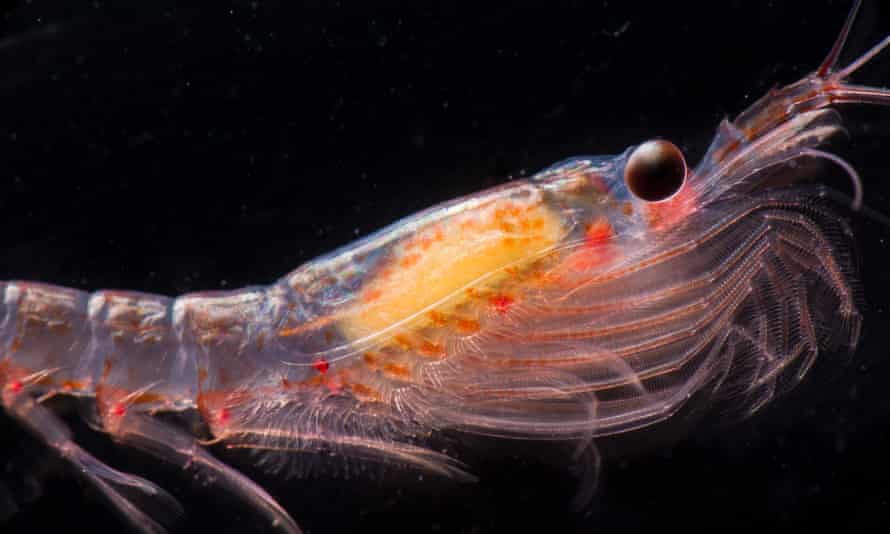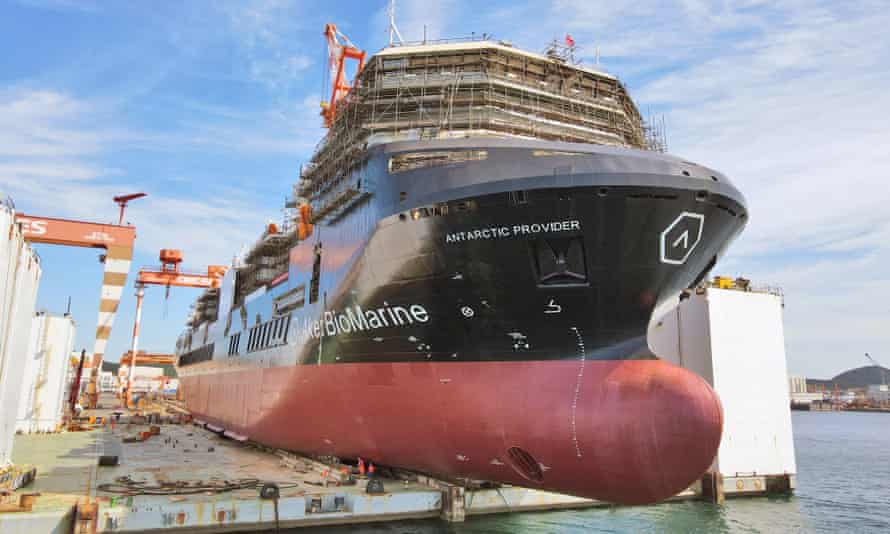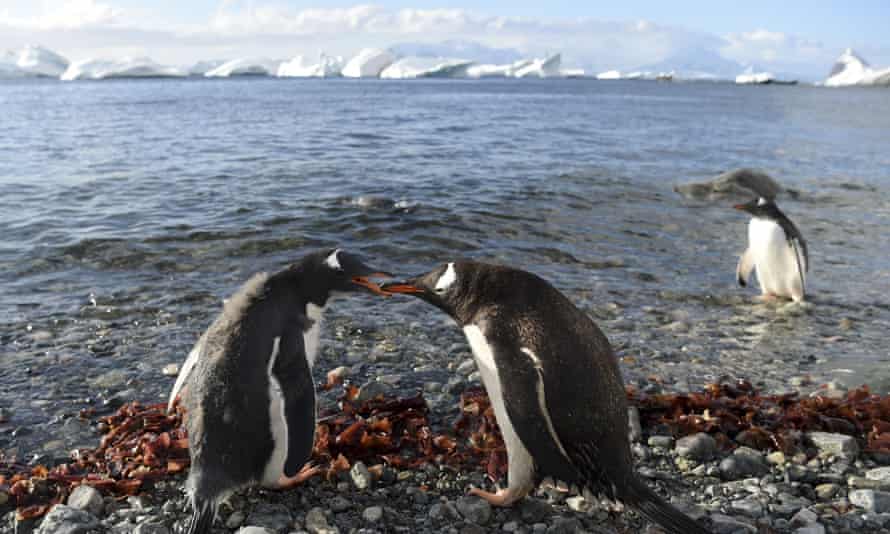Licence to krill: the destructive demand for a ‘better’ fish oil

Industrial fishing of the tiny crustacea in a dietary supplements gold rush is threatening the very base of the food chain
This article was produced with the Environmental Reporting Collective, whose full report is part of the Oceans Inc collaborative investigative series on illegal, unreported and unregulated fishing
Last modified on Tue 7 Sep 2021 05.21 EDT
It’s a costly expedition, through some of the roughest seas in the world, to reach the Antarctic peninsula. A journey through Drake Passage to Subarea 48.1 faces treacherous weather, where waves can reach 12 metres (40ft) high.
And yet it is a risk that 14 vessels considered worth taking last year alone, as countries increasingly venture into the Antarctic to catch a species with great value to the billion-dollar health supplement industry: krill.
Each roughly the size of a paperclip, Antarctic krill is the most abundant species on Earth. There are an estimated 400m tonnes of krill in the Antarctic alone. It is a key link in the food chain: krill contributes iron and other nutrients that fertilise the ocean, and is a vital food source for wildlife including whales, penguins and seals.
It also plays an integral part in the carbon cycle. The Southern Ocean is one of the largest carbon sinks in the world, and krill are so numerous they can influence atmospheric carbon levels. One study found that krill can remove up to 12bn tonnes of carbon from the Earth’s atmosphere.

While krill have long been used in aquaculture to fatten farmed fish, krill oil has become a gold rush for the dietary supplements industry in the past decade. Marketed as a superior and sustainable alternative to fish oil pills, Antarctic krill products are touted as more effective in delivering omega-3 fatty acids to the bloodstream than fish oil, which has been linked to improved heart and brain health – among many other benefits. And there is no fishy aftertaste.
With growing concerns about overfishing and the quality of fish oil, producers also promote krill products as a premium and more environmentally friendly substitute. One bottle sold on Amazon promises krill “sustainably harvested from pristine waters … to ensure maximum nutrient quality”.
But for all the claims of sustainability, the rise in demand has seen quotas reached with alarming speed. A recent cross-border investigation into the global fishing industry by the Environmental Reporting Collective found that in the past year, catch limits for Antarctic krill in Subarea 48.1 were reached in 69 days, as opposed to an average of 130 days over the previous five years.
“It’s pretty worrisome when you’ve got fisheries exploring these ‘unexploited’ areas or discovering large stocks of fish,” says Teale Phelps Bondaroff, director of research at OceansAsia. “This really should raise eyebrows because what’s really driving that expansion? Krill oil is obviously one factor.”
The international organisation that manages the Antarctic krill fishery, the Commission for the Conservation of Antarctic Marine Living Resources (CCAMLR), insists their practices do not disrupt the marine ecosystem.
Krill vessels monitor their own locations, it says, and diligently report their catch to CCAMLR, which sets strict catch limits around the Antarctic.

But it is clear that in some areas – the most vulnerable ones, according to conservationists including Bondaroff – those limits are being disrupted as countries rush to join the race.
China is building the world’s largest Antarctic krill trawler, scheduled to be completed in 2023, and the country more than doubled its catch of Antarctic krill from 50,423 tonnes in 2019 to 118,353 tonnes in 2020. Russia, too, is investing $640m (GBP460m) in krill fishing, and South Korea is also registering more ships.
The retail krill oil industry is projected to grow by more than 13% by 2023, though most of the krill catch still goes to feeding fish, pets and livestock. Aquaculture is the fastest-growing animal food industry, and Antarctic krill offer more nutrients and fewer pollutants, making it particularly attractive for farmed salmon.
“It’s growing, and I think it’s a question of ‘can the fishery be effectively managed before it expands further?'” says Nicole Bransome, of Pew’s Protecting Antarctica’s Southern Ocean project.
Last year, more than half of the krill was caught by one company: Aker BioMarine. The largest industry player since the 1990s, it is part of the Aker empire controlled by the Norwegian billionaire Kjell Inge Rokke. The company, which spans oil and gas, construction, marine biotechnology and energy, acknowledges that the catch has been going up in recent years, but insists: “We want to harvest, of course, but we want to secure our harvesting potential for 10 or a hundred years … we need to be in a place where our activity is accepted by a wide range of stakeholders.”
Although there are only about a dozen krill fishing vessels in the Antarctic, their number belies their impact. The ships are floating factories, some the size of football pitches, capable of vacuuming up more than 1,000 tonnes of krill a day.
“It’s not like you could just take a small boat and go and start to harvest krill,” says Ekaterina Uryupova, visiting fellow at Washington’s Arctic Institute.
“You have to prepare yourself and be ready for all kinds of weather, for all kinds of situations. Then you have to find the best location to catch krill, and then once your fridges are full, you have to cover the same distance back.”

Conservationists fear fishing is concentrated in areas crucial to species that depend on krill as a food source.
Rodolfo Werner, of the Antarctic and Southern Ocean Coalition, says: “The fishery was fishing over and over in certain areas close to the coast where on one side are colonies of penguins and on the other side are areas popular for foraging whales.”
Most vessels operate in Area 48, an immensely biodiverse region that is home to more than 62m tonnes of krill.
In 2010, CCAMLR set a catch limit of 620,000 tonnes across four areas to prevent concentrated fishing. In theory, once the limit is reached, all krill fishing must stop until the next year.
Krill fishing is within the limit but last year’s catch in Area 48 was almost 450,000 tonnes, up by 15% from the year before.
Subarea 48.1 has the smallest limit, 155,000 tonnes, due to its significant ecological importance. Colonies of penguins and seals live close to the shore, and in the summer whales feed on krill. Conservationists are concerned that the catch limit has been reached eight times in the past decade.
“If you’re really pushing up to the last number of krill that you can pull out of the water, that doesn’t give any buffer for challenges like climate change,” says Bondaroff.
Even within Subarea 48.1, fishing is concentrated in a tiny pocket. Between 2010 and 2018, 74% of the total catch there came from around the Bransfield strait, which represents only 8% of the area. In another region, Subarea 48.3, it was even more concentrated: 95% of the catch came from just 5.6% of the area.
Bransome fears the quotas, which cover such a wide area, are only being caught in these small locations. “So they’re not overfishing in the entire Antarctic, but if you look at these very small areas, they are. And that’s what actually matters to the wildlife there,” she says.
In October, in a pivotal moment for krill, CCAMLR’s 26 members, 25 countries and the EU, will decide at its annual meeting whether to revise catch limits for Area 48, or eliminate them altogether – which would happen if no agreement is reached.

“And that would allow the fishery to really concentrate their catch. If that happens, that could be quite destructive to the ecosystem,” says Phil Trathan, a conservation biologist at the British Antarctic Survey.
CCAMLR argues that catches of krill in the Southern Ocean are at precautionary levels. It notes that less than 1% of krill in the Antarctic is fished annually.
“This is one of the few resources that is still underexploited in a very big way in the global oceans,” says David Agnew, of the CCAMLR.
But with a higher interest in krill, scientists are concerned about the effect on the food chain.
“You cannot have an infinitely contracting and concentrating fishery with an increasing number of actors being involved and no change in that structure. Something has to change,” says Andy Lowther, a quantitative ecologist at the Norwegian Polar Institute. “Either the quota needs to go up or the area needs to expand or fewer actors need to be involved in the fishery.”
Research from last year suggests that concentrated krill fishing is reducing locally available amounts of krill, which has badly affected penguins, including population declines for certain species.
“When you’re fishing for krill, what you’re doing will affect the whole ecosystem, because every species in Antarctica feeds on krill or on another species that feeds on krill,” says Werner.
Changes to krill populations are proving to be critical, too. A study published in June said krill populations are projected to fall by 30% by 2100, due to the climate crisis. The Antarctic peninsula is among the fastest-changing regions, warming almost 3C over the last 50 years.
In particular, krill are shifting south towards the pole as the ocean warms. If krill continue moving south, less food would be available for predators in sub-Antarctic islands, such as seals and penguins.
“We’re not dealing with a static system. It’s changing because of the warming planet,” says Trathan. “I would say we’re heading towards one of the most challenging years.”
A 2019 study revealed that krill are already facing increasing difficulty in replenishing their population at Southern Ocean’s northern edge, close to Area 48.
Says Bransome: “It really speaks to what we’re doing to our oceans in general: that we fished so much that we now have to go down to this place that’s at the bottom of the world.”
